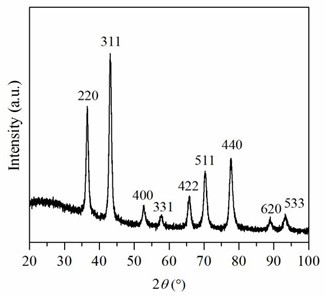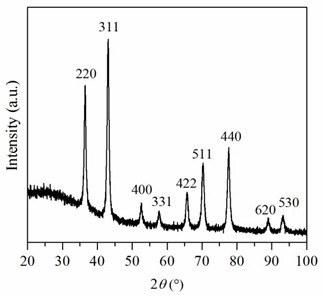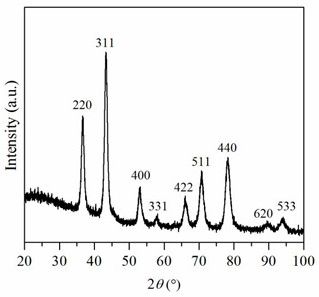A kind of non-stoichiometric zinc-aluminum spinel and its preparation method
A non-stoichiometric ratio, zinc-aluminum spinel technology, applied in chemical instruments and methods, inorganic chemistry, zinc compounds, etc., can solve the problem of limiting the performance and application of zinc-aluminum spinel, and the difficulty in obtaining pure zinc-aluminum spinel , Zinc-aluminum spinel grain size is large and other problems, to achieve the effect of adjustable zinc-aluminum molar ratio, low cost, high purity and crystallinity
- Summary
- Abstract
- Description
- Claims
- Application Information
AI Technical Summary
Problems solved by technology
Method used
Image
Examples
Embodiment 1
[0023] Weigh 6.7423g Zn(NO 3 ) 2 ·6H 2 O and 8.5019g Al(NO 3 ) 3 9H 2 O and dissolved in 100 mL deionized water to prepare a zinc-aluminum mixed solution. Press Na 2 CO 3 The molar mass of Al(NO 3 ) 3 9H 2 Weigh 1.2011g of anhydrous Na with 0.5 times the molar amount of O 2 CO 3 , dissolved in 100 mL deionized water to prepare Na 2 CO 3 solution. Weigh 20g NaOH, dissolve it in 250mL deionized water, and prepare 2 mol / L NaOH solution. At room temperature and under magnetic stirring, the zinc-aluminum mixed solution was added dropwise to Na 2 CO 3 solution. At the same time, NaOH solution was added dropwise to Na 2 CO 3 solution, adjust the NaOH solution drop rate with a peristaltic pump to keep the pH of the solution = 10 ± 0.5. After the dropwise addition, it was left to age for 24 h, then suction filtered, and washed with deionized water until the pH of the filtrate = 7±0.2. Afterwards, the obtained solid was dried in an oven at 100 °C for 12 h to obtain ...
Embodiment 2
[0026] Weigh 8.3499g Zn(NO 3 ) 2 ·6H 2 O and 5.2646g Al(NO 3 ) 3 9H 2 O and dissolved in 100 mL deionized water to prepare a zinc-aluminum mixed solution. Press Na 2 CO 3 The molar mass of Al(NO 3 ) 3 9H 2 0.5 times the molar weight of O, weigh 0.7437g anhydrous Na 2 CO 3 , dissolved in 100 mL deionized water to prepare Na 2 CO 3 solution. Weigh 20g NaOH, dissolve it in 250mL deionized water, and prepare 2 mol / L NaOH solution. At room temperature and under magnetic stirring, the zinc-aluminum mixed solution was added dropwise to Na 2 CO 3 solution. At the same time, NaOH solution was added dropwise to Na 2 CO 3 solution, adjust the NaOH solution drop rate with a peristaltic pump to keep the pH of the solution = 10 ± 0.5. After the dropwise addition, it was left to age for 24 h, then suction filtered, and washed with deionized water until the pH of the filtrate = 7±0.2. Afterwards, the obtained solid was dried in an oven at 100 °C for 12 h to obtain zinc-al...
Embodiment 3
[0029] Weigh 9.0711g Zn(NO 3 ) 2 ·6H 2 O and 3.8128g Al(NO 3 ) 3 9H 2 O and dissolved in 100 mL deionized water to prepare a zinc-aluminum mixed solution. Press Na 2 CO 3 The molar mass of Al(NO 3 ) 3 9H 2 0.5 times the molar weight of O, weigh 0.5386g anhydrous Na 2 CO 3 , dissolved in 100 mL deionized water to prepare Na 2 CO 3 solution. Weigh 20g NaOH, dissolve it in 250mL deionized water, and prepare 2 mol / L NaOH solution. At room temperature and under magnetic stirring, the zinc-aluminum mixed solution was added dropwise to Na 2 CO 3 solution. At the same time, NaOH solution was added dropwise to Na 2 CO 3 solution, adjust the NaOH solution drop rate with a peristaltic pump to keep the pH of the solution = 10 ± 0.5. After the dropwise addition, it was left to age for 24 h, then suction filtered, and washed with deionized water until the pH of the filtrate = 7±0.2. Afterwards, the obtained solid was dried in an oven at 100 °C for 12 h to obtain zinc-al...
PUM
| Property | Measurement | Unit |
|---|---|---|
| particle size | aaaaa | aaaaa |
| specific surface area | aaaaa | aaaaa |
| particle size | aaaaa | aaaaa |
Abstract
Description
Claims
Application Information
 Login to View More
Login to View More - R&D
- Intellectual Property
- Life Sciences
- Materials
- Tech Scout
- Unparalleled Data Quality
- Higher Quality Content
- 60% Fewer Hallucinations
Browse by: Latest US Patents, China's latest patents, Technical Efficacy Thesaurus, Application Domain, Technology Topic, Popular Technical Reports.
© 2025 PatSnap. All rights reserved.Legal|Privacy policy|Modern Slavery Act Transparency Statement|Sitemap|About US| Contact US: help@patsnap.com



